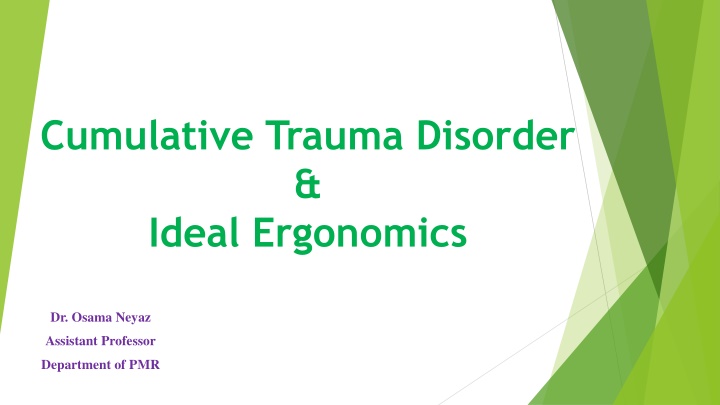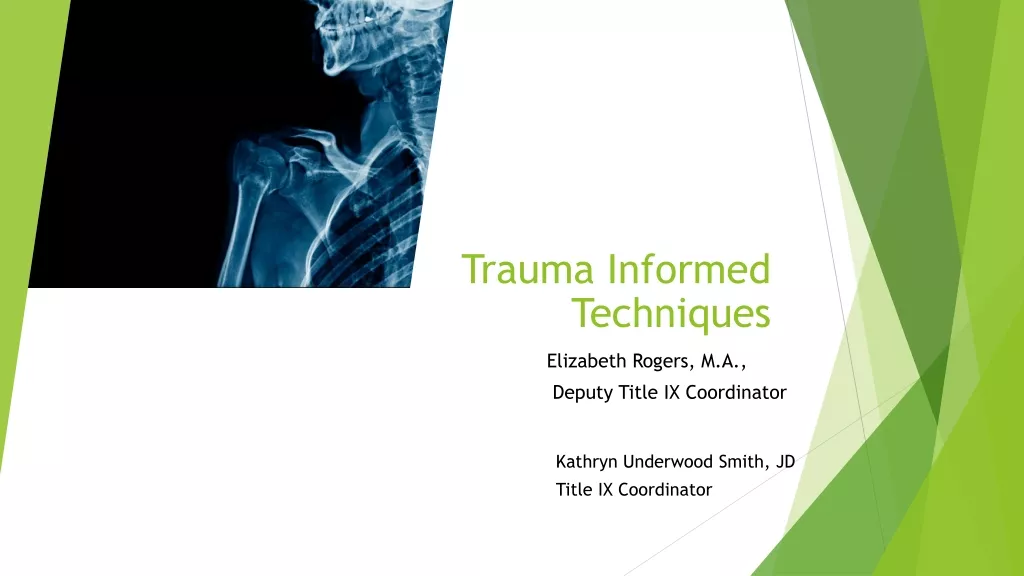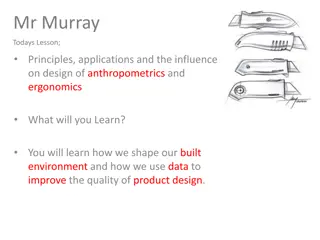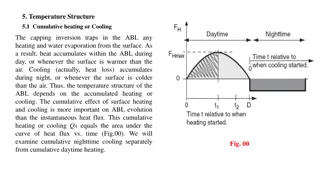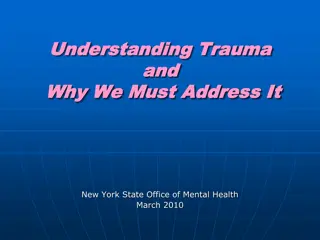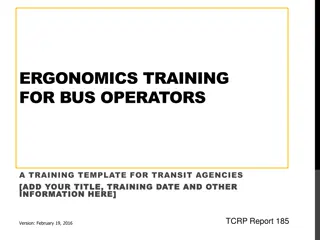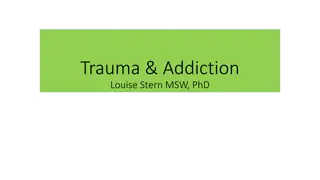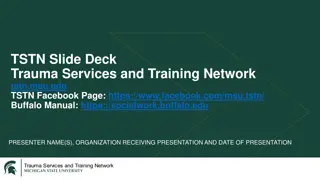Cumulative Trauma Disorder & Ideal Ergonomics
Cumulative Trauma Disorder (CTD) is a work-related musculoskeletal injury caused by ergonomic hazards. Learn about its stages, clinical features, treatment, and the importance of ideal ergonomics to prevent CTD.
Download Presentation

Please find below an Image/Link to download the presentation.
The content on the website is provided AS IS for your information and personal use only. It may not be sold, licensed, or shared on other websites without obtaining consent from the author.If you encounter any issues during the download, it is possible that the publisher has removed the file from their server.
You are allowed to download the files provided on this website for personal or commercial use, subject to the condition that they are used lawfully. All files are the property of their respective owners.
The content on the website is provided AS IS for your information and personal use only. It may not be sold, licensed, or shared on other websites without obtaining consent from the author.
E N D
Presentation Transcript
Cumulative Trauma Disorder & Ideal Ergonomics Dr. Osama Neyaz Assistant Professor Department of PMR
Synonyms Cumulative trauma disorder Repetitive motion syndrome Repetitive strain injury Work related disorder Myofascial pain
Overview Introduction Definition Patho-mechanics Stages Clinical feature Clinical Evaluation Treatment Ergonomics
Introduction A. Cumulative: developed gradually over periods of weeks, months, or even years. cumulative concept: each repetition of an activity produces some trauma or wear and tear on the tissues and joints of the body. B. Trauma: bodily injury from mechanical stresses. C. Disorders: physical ailments or abnormal conditions.
Definition CTD are work-related musculoskeletal injuries that affect the musculoskeletal, peripheral nervous, and neurovascular systems that are caused or aggravated by occupational exposure to ergonomic hazards.
Common CTDs Neck tension syndrome Pronator teres syndrome Rotator cuff syndrome Radial tunnel syndrome Epicondylitis Carpal tunnel syndrome Tendonitis Guyon tunnel syndrome Tenosynovitis Ganglion Trigger finger
Mechanisms of injury 1) Sustained or constrained Posture 2) Repetition 3) Forcefull exertions 4) vibration 5) combinations
Patho-physiology Continuous contraction of muscles from long- term static load with insufficient breaks Tissue ischemia and delayed dissipation of metabolites Physiological strain (muscle fatigue & pain) Impaired circulation
Stages Stage 3 Stage 2 Stage 1 Pain is present while working Mild discomfort while working Pain is present all the time. Work is affected. Continues when not working. May be taking pain medication. Disappears when not working May not be able to complete simple daily tasks. Does not affect work or daily living tasks. Begins to affect work and daily living tasks. Not reversible, can improve (but not a full recovery). Completely reversible. Completely reversible.
Signs and symptoms Pain Tenderness Swelling Unreasonable fatigue Disturbed sleep Tingling & Numbness Difficulty performing tasks or moving specific parts of the body
Clinical Evaluation Identifying the specific injury Determine the degree to which the disorder is work related Each disorder has different cause, treatment & prognosis
History Elicit the onset, location, duration, frequency, intensity of the symptoms Whether symptoms started before or after employment If symptoms exacerbated by the job Previous injuries or fracture to that area If any medical condition known to be associated with symptoms
Physical examination Inspection for sign of inflammation, ganglia cysts or deformity Palpation - warmth Passive, active & resisted ROM Special tests e.g. Phalen s test, Finkelstein s test
Medical conditions associated with CTD Amyloidosis I. Arthropathies & connective tissue disorders e.g. RA, SLE, II. gout, OA and SpA III. Cancer IV. Diabetes mellitus Hypothyroidism V. VI. Obesity VII. Pregnancy
LABORATORY TESTING CBC ESR and CRP Serum RF, Antinuclear antigen (ANA), HLA-B27 Diabetic screening S. TSH S. calcium, phosphorus, uric acid, alkaline and acid phosphatase for metabolic, endocrine and neo-plastic conditions Serum protein electrophoresis
Treatment Rehabilitation programme Application of Heat and Cold NSAIDs Exercises Splints Surgical intervention if conservative trail fails.
Ergonomics The science of studying people at work and then designing tasks, jobs, information, tools, equipment, facilities and the working environment so people can be safe and healthy, effective, productive and comfortable * Fitting Fitting the job to the the job to the worker worker *Ergonomic Design Guidelines, Auburn Engineering, Inc., 1998.
Posture is the most important aspect when looking at workstation design.
Chairs Height Back support Seat tilt Depth Width Armrests
Height Highest point of the seat, just below your kneecap. Feet should rest firmly on the floor when seated
Back support & Seat tilt Lumbar pad should supports the natural curve of your lower back (lumbar curve). Upper body should slightly tilt to reclined. *110 is usually recommended. Seat tilt of 5 is usually recommended.
Seat Depth & Width The seat pan should support the back without the front of the seat pressing against the back of your knees. Wide enough not apply pressure to your thighs. Narrow enough to reach the armrests.
Armrests Armrest should be adjusted to elbow height. Too high will shrug the shoulders Too low will depressed the shoulders - Affect the posture of the back and neck.
Input devices Position - Upper arms should be relaxed and by your side, your elbows bent at a right angle (90 degrees) and your wrists straight. Keyboard should promote neutral wrist and hand posture. Negatively tilted keyboard Mouse same level as the keyboard easy to reach switch the side by changing hands
Monitor Distance As far away as possible (60-90 cm) Increase the size of the font Height and location Top of the monitor just below eye level Tilt 15 degrees
Computer & Desk Stretches Approximately four minutes Do these stretches every hour
Thank you Thank you
